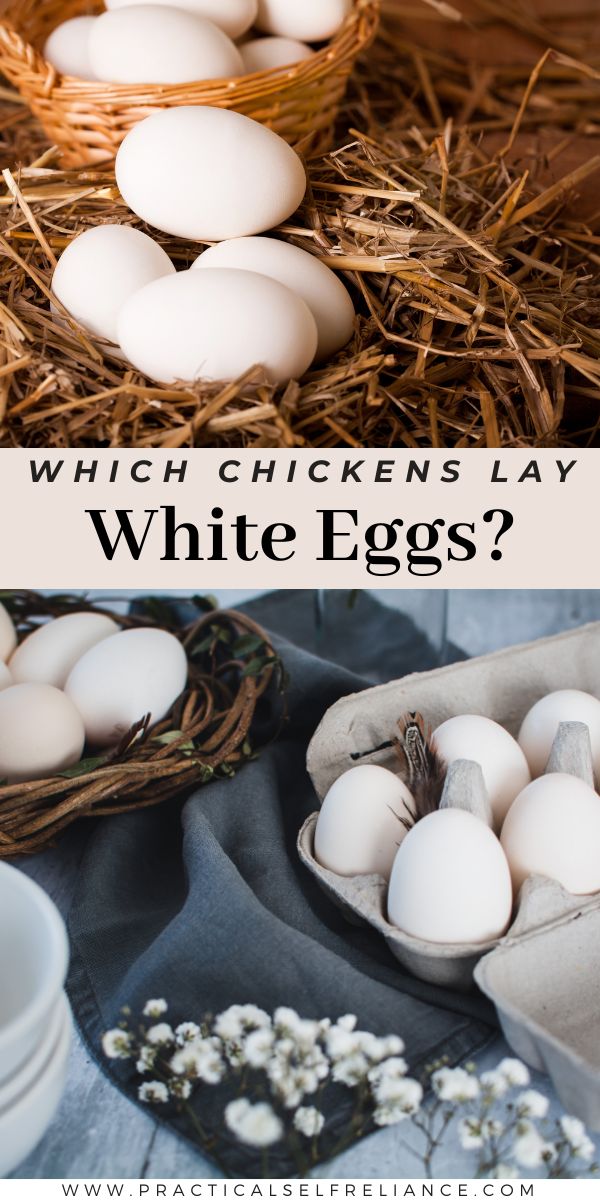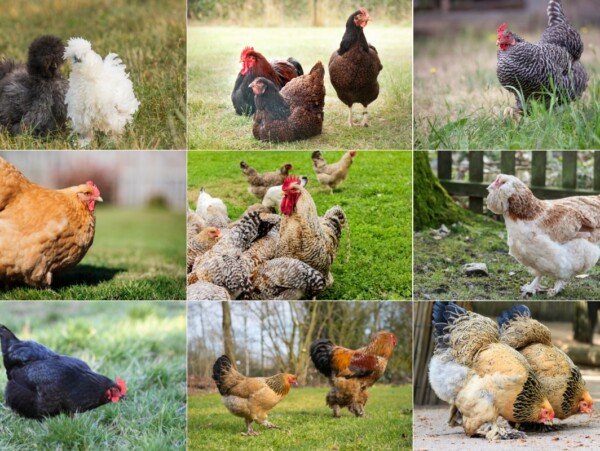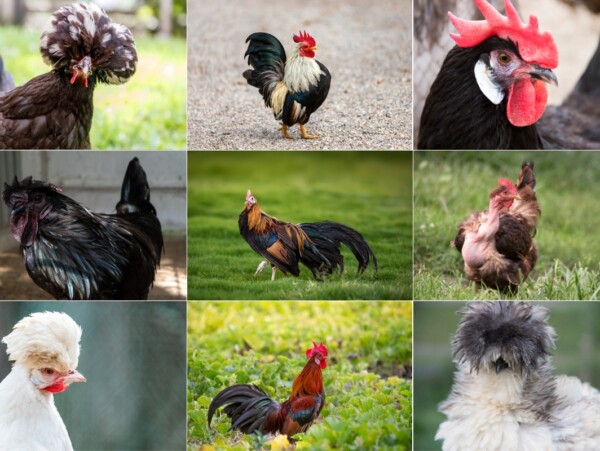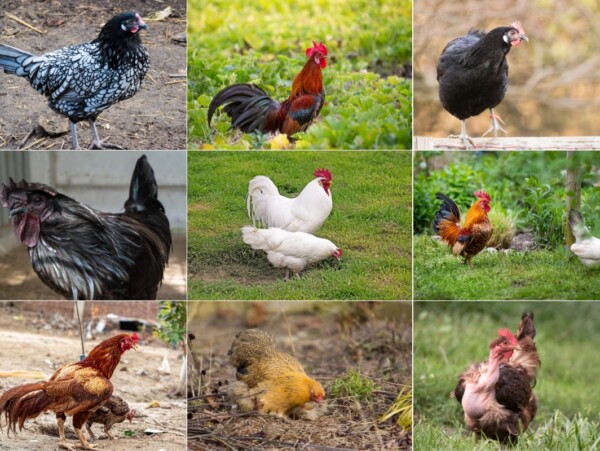Affiliate disclosure: This post may contain affiliate links. Please see our Privacy Policy.
Chickens that lay white eggs were once the norm, but these days most backyard flocks lay brown eggs (or feature a range of colors). The thing is, white egg chickens are some of the most dependable and adaptable breeds, and there’s a reason they were the standard until recently. If your goal is low maintenance and high production, white egg chickens are often your best bet.
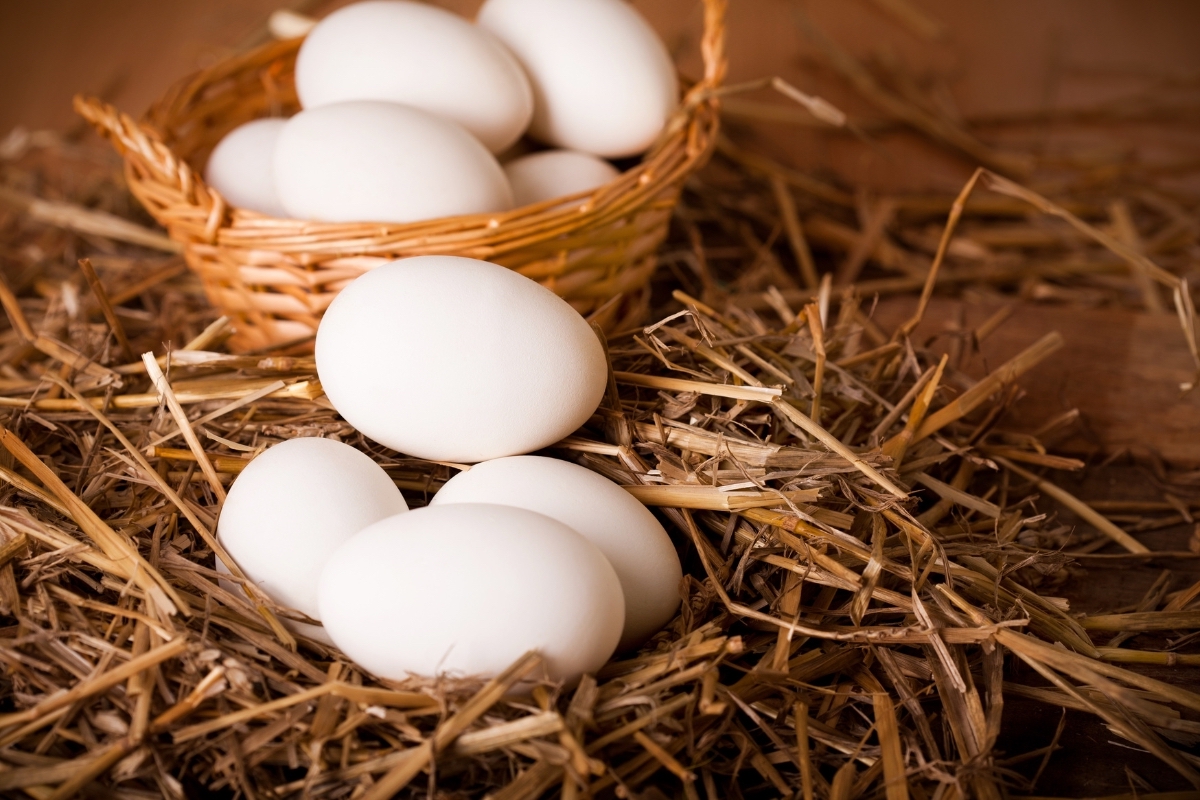
White eggs used to be the standard, both commercially and in backyard flocks. Sometime about 50 or so years ago, there was a common misconception that “brown eggs are healthier” or “brown eggs mean farm fresh” when in reality, the eggshell color is more about the breed than how the chickens were kept.
If you choose the right chicken breed, you can have almost any color of chicken eggs, including easter egg chicken breeds that lay blue eggs, and olive egger breeds that lay green eggs.
Oddly now, as people try to incorporate a rainbow of egg colors into their backyard chicken flock, white egg-laying chickens are becoming popular again. Adding a bright splash of white is a great way to brighten up an egg basket with a little contrast, and they’re hardy, dependable layers that get the job done.
How are White Chicken Eggs Formed?
All chicken eggs, regardless of color, have their beginnings in the hen’s ovary, of which there is only one. When ovulation occurs, a yolk is formed in the ovary. In these very early stages the yolk is called an oocyte—once formed, it’s released into the oviduct where it will develop into a finished egg with a shell.
The oviduct is a two-foot tubular part of the hen’s anatomy, it’s also the place where the oocyte will develop all of its characteristics over a 24 to 26 hours time period. It is when the egg is moving through the oviducts that it can be fertilized by a rooster.
The eggshell is formed at the very end of this process out of a naturally white mineral called calcium carbonite. For white chicken eggs, this is where the process ends. For colored eggs (of any color) pigment is added during the last 90 minutes of the egg’s journey before it’s laid.
Where do White Egg Chickens come from?
Unlike certain breeds that lay a very specific color of egg, such as blue eggers (which, for the most part, originated in South America), white egg chickens come from all over the globe.
Below you’ll find white egg laying chicken breeds that come from countries such as Turkey, Egypt, Italy, Spain, and the United States. The geographical origin of these chickens tells an incredibly interesting story about the breed and its history—one that I would definitely suggest researching in greater detail if you decide to keep any of the following breeds.
White Egg Laying Chicken Breeds
When it comes to chickens that lay white eggs, there is a huge variety to choose from in terms of size (both of the bird and the eggs themselves), personality, hardiness, and origin of the breed. You’ll also want to consider the amount of space you have to offer—coop size as well as outdoor space—and whether or not you have noise by-laws to consider.
White eggs are readily available from many types of chickens, and the following list of breeds will give you the most pertinent information you need to make an informed choice.
Black Minorca
This breed originated in Minorca, Spain, where the chickens were first bred for their large size (fun fact: Black Minorcas are the biggest out of all the Mediterranean breeds). While Black Minorca hens aren’t known for their egg-laying abilities (they’ll only lay around 120 eggs per year), their jumbo white eggs are considered to be the largest out of any standard breed.
Because of their heritage, these birds are very tolerant of warm temperatures—this isn’t a cold hardy breed by any means. Black Minorcas are excellent foragers and do well when allowed to roam free range in the yard. As long as you don’t mind a lower yield of fresh eggs, this is the perfect breed for home cooks since their giant eggs are outstanding when used in egg dishes and egg-based baked goods.
White Leghorns
Another Mediterranean breed (this time from Tuscany, Italy), White Leghorns are highly productive egg layers—you can expect 5 to 6 large or extra-large eggs per week or up to 320 eggs per year! White Leghorns are medium-sized chickens, weighing in at 5 to 8 pounds, and have white feathers with a red comb.
Leghorn’s are utilitarian egg layers and are not well-known for having friendly dispositions towards people or their own offspring; this is not a broody breed! White Leghorns are very cold hardy as long as there’s a source of protective coverage; they can also tolerate the heat fairly well. A word of warning about Leghorns: this breed likes to make a lot of noise, so is best suited for rural coops versus urban environments.
Ancona
Another breed from Italy, Ancona chickens are thought to be distantly related to Leghorns. Like Leghorns, Ancona hens are excellent egg layers, producing 5 or more medium- to large-sized white eggs per week or up to 280 per year. In terms of appearance, Anconas have striking black feathers with v-shaped white tips.
Because of this breed’s Mediterranean origins, Anconas are warm weather-hardy and will tolerate cold temperatures if given protection from the elements. Anconas are social birds and will thrive in the company of other birds, particularly if you own three or more.
Polish
A white egger with a flamboyant crown of resplendent fanned-out feathers, the striking appearance of these chickens made them a favorite of the French aristocracy in the 1700s. In fact, the unseated King of Poland escaped from France in 1736 with his collection of Polish chickens in tow). When it comes to egg laying, you can expect 3 to 4 medium-sized white eggs per week or up to 200 per year from this beautiful breed.
These birds do well in confinement—always preferring a clean coop—and have particularly curious little personalities which can lead to unsafe situations if they’re left free to roam. Polish chickens are known for their calm, gentle personalities and can even be kept as pets by children. Because of their ornate feathering, Polish chickens should be kept dry and away from cold conditions, as their feathers are prone to freezing and clumping.
Holland
Originally developed in the US, Holland chickens are a medium-sized, dual-purpose breed as they lay plenty of eggs while also being bred for their meat. There are two types of Holland chickens, Barred and White, and both breeds will produce 3 to 4 medium- to large-sized white eggs per week week or up to 240 per year. This breed is known for its many positive traits, including being adaptive, docile, cheerful, and gentle.
Unsurprisingly, Holland hens are broody and will take excellent care of their chicks. This breed will do best when given plenty of room to forage and to roam free range. A fairly hardy bird in both cold and hot conditions, Hollands should be protected against frostbite when the temperature drops.
Egyptian Fayoumi
A breed with an origin story that can be traced all the way back to ancient Egypt and the time of the Pharoahs, Egyptian Fayoumi chickens are a relative newcomer to the United States. Now recognized for being decent egg layers, you can expect Egyptian Fayoumi hens to lay between 150 and 200 small white eggs per year—making them a very sweet addition to any egg basket.
This breed loves to roam free range, and they are hyper-aware of predators and potential food sources. A breed that can fly, if given the opportunity Egyptian Fayoumis will roost in trees. It’s important to be aware that Egyptian Fayoumi chickens aren’t a particularly friendly breed and are unlikely to warm up to their human owners.
California White
It would be easy to mistake this breed for White Leghorns if the white plumage of California Whites weren’t covered with small black polka dots. A medium-sized breed, the hens, are amazing layers of jumbo-sized white eggs—about 5 per week or up to 300 per year (in fact, if you didn’t know better you might mistake them for duck eggs!).
A low-maintenance breed, California Whites are friendly, quiet, and in many ways an ideal breed in every way. California Whites love to roam free but will quickly adapt to small spaces on top of being hardy to both cold and hot temperatures.
Hamburg
Hamburgs are an ancient breed of chicken, with ornithologists theorizing they first originated in Turkey. Over time, Hamburgs were brought over to Germany where the breed first got their current German name. A small, ornamental breed, Hamburg hens will lay approximately 120 to 225 small- to medium-sized white eggs per year with this number is largely dependent on the age of the hen.
Hamburg chickens are alert and active, this isn’t a breed that’s known for its friendliness and is more known for its flightiness. Another breed with the ability to fly, these birds prefer roosting high up in trees and in hedgerows. Hamburgs aren’t fans of confinement of any sort, which makes their hardiness to cold and hot temperatures an important behavioral trait.
Chicken Guides
Looking for more guides to help you with your backyard flock?
- How Much Does it Cost to Raise Chickens?
- Easy Homemade Pickled Eggs
- Duck Eggs vrs. Chicken Eggs: What’s the Difference?
- Storing Eggs in Limewater (Keeps 12+ Months!)
- 30+ Ways to Preserve Eggs
